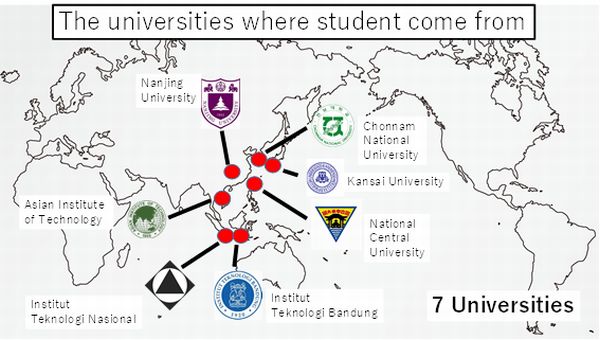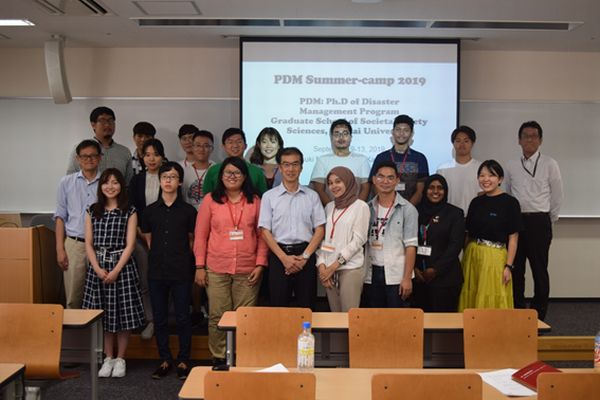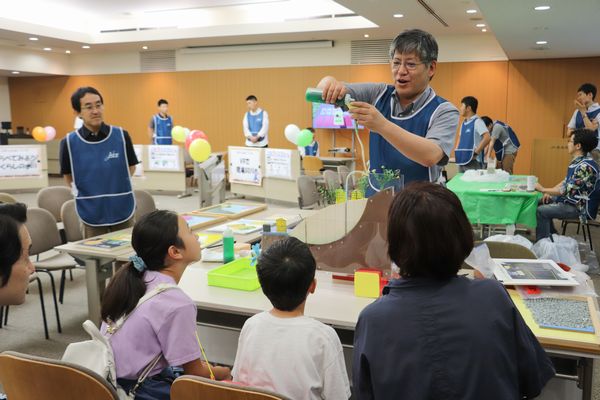IAC News
IAC News No.86, December 2019
Japan Society of Civil Engineers International Activities Center Dec 2, 2019 IAC News No.86
PDM (Ph.D. of Disaster Management Program),
Kansai University and PDM Summer Camp

Koji Ichii
(Kansai University)
This article is supposed to be the information exchange for the international activities/international courses in civil engineering. As the course of civil engineering education in Kansai University, there has been Faculty of Environmental and Urban Engineering in the main campus of Kansai University. However, the field for civil engineers’ activity is not limited in the traditional field of civil engineering, but it is spreading into multi-disciplinary field such as disaster mitigation and accident prevention. Thus, this time, I would like to introduce graduate school education in Faculty of Societal Safety Science and Graduate School of Societal Safety Science in Kansai University, which relate to the field of civil engineering.
The Faculty of Societal Safety Science and Graduate School of Societal Safety Science in Kansai University were founded in 2010, and these are quite new educational programs. The programs are committed to the development of human resource equipped with practical skills to analyze safety problems that abound in modern society and formulate proposals for possible solutions. Although the number of faculty staff is not quite large (full-time faculty staff is less than 30), the faculty staff deals with various research field such as engineering, law, psychology, sociology, economics, etc. Currently, five faculty staffs members with the background of civil engineering are working on various disasters such as tsunami, flood, geo-disaster, and earthquake engineering.
There are not so many faculties which condcut the research/education of safety of society, focusing on disasters and accidents. Especially, it may be the only educational program to solve problems related to safety of the society, from both perspectives of social science and natural science including the staff of civil engineering background. However, the education from both sides of social science and natural science is not easy. Especially, it is quite difficult to offer that in English. For example, you can imagine how hard it would be to discuss Japanese legal systems in English (of course, the related laws are written in Japanese), and vice versa. I recently have recognized that the field of civil engineering is more easy to work together in global, with less feeling of the barriers from language and country differences.
However, the recent circumstances imposes Japanese universities to offer the international education program. For example, in order to teach appropriate international communication skills to Japanese students, it is necessary to provide them with many opportunities to meet foreign students. Of course, it might be too much to have the goal as “half of the classes in schools shall be conducted in English.” It is obvious that most of Japanese students who have just graduated from regular high schools cannot understand the contents of the classes, if the classes are in English. The important thing is the skills to work without allergic reactions to foreign languages. The skills include the usage of translation systems in internet, such as google translation. I think these skills can be obtained in the opportunity which they work with foreign students.
As a result of discussions of the necessity to enhance international education, the Graduate School of Societal Safety Science in Kansai University launched English-based Ph.D. Program: PDM(Ph.D. of Disaster Management Program). Some of the faculty staff deliver classes in English. In addition to writing dissertation, students are required to take at least three lecture classes such as psychology of societal safety, risk management, economics of disasters and policy analysis for disaster reduction, urban disaster reduction planning.
As the celebration of the 10th year of the faculty and launch of PDM, we have international symposiums and students summer camp in 2019. In the summer camp, some students from related universities in Asia were invited, and these invited students together with students from Kansai University did some group works. Total 17 students from 7 universities in 7 countries including Kansai University (Figure 1) spent together in a seminar house of Kansai university for one week. They were requested to compare between disasters in Japan and those in other countries. In addition, they were requested to make a proposal about disaster mitigation based on comparisons and anaylses that they made. Their group work results were introduced by oral and poster presentations at the international symposium. Photo 1 shows the participants of the summer camp, and Photo 2 does their posters with a Ph.D. student in PDM from ITB, Indonesia. Each student group made 2 posters for the comparison of disasters and the proposal of countermeasures, and heated discussions were carried out in the poster presentation.
Most of the participants said, “I was really nervous to join the program at first ”; however, all of them got good experiences making friends with each other. Some students also said, “We need to be familiarize ourselves with each other to complete such heavy tasks in a short time.” It is true that the tasks were so heavy to finish within one week, and some students regret that they couldn’t complete task at a satisfactory level due to the limitation of time. Anyway, including their feeling of regret, it was a good educational program. At least for me, I am really satisfied with the program, since the students had quite good facial expressions showing their growth. In a sense, it was a really happy time for me as a teacher.
The preparation of such international activity is quite tough, and it also costs much. Thus, it is difficult to have summer camp every year. For PDM, Kansai University, not the memorial event but the continuous and substantial education in the program is the most important task. Anyway, sharing of good practices and know-how to conduct activities are important for us, and I am very happy if this article is informative for you.

Figure 1 The Universities of the Participants in PDM Summer Camp 2019 in Kansai University

Photo 1 Participants of PDM Summer Camp 2019 in Kansai University

Photo 2 Posters of the Group Works (4 Groups and 2 Posters from Each Group)
and a Ph.D. Student of PDM Program, Kansai University (Ms. Karina Sujatmiko from ITB, Indonesia)
【Reported by Koji Ichii, Professor,Faculty of Societal Safety Science, Kansai University】
Report on JSCE Open Campus 2019
Natural disasters such as earthquakes, floods, landslides, and river inundations frequently occur throughout Japan, which highlight the importance of civil engineering. The JSCE Communications and Public Relations Center has held the JSCE Open Campus since 2017 as part of its efforts to communicate the attractiveness of civil engineering, which is essential for a safe and secure life, and to boost interest in civil engineering.
For this event, we open the headquarter premises of the Japan Society of Civil Engineers to the public. Using materials, technologies, and knowledge of the Society and its members, we provide opportunities for “listening to”, “looking at”, and “touching” civil engineering. As a result of proactive public relations activities at places such as local elementary schools, 283 people (138% year on year) visited the third Open Campus this year. Six committee members from sectors including investigation and research participated as staff in the event, and entertained visitors by demonstrating the attractiveness of civil engineering.
In Doboku-Fureai Festa (an event to enjoy civil engineering), which is popular among children, there were 10 experience-based programs on the themes of the mechanism of landslide disasters, the shapes of bridges and tunnels, the water quality of tap water and nearby rivers, the material characteristics of concrete, disaster prevention, etc. These programs were intended to make children enjoy learning about civil engineering
With the Olympics approaching in 2020, in the special exhibition 1964 Tokyo Olympics, we displayed magazines and videos published in 1964 and valuable exhibits from the collection of the JSCE Library. Engineering drawings used for the construction of the Tokaido Shinkansen, scenes from the construction, and the achievements of civil engineers were presented.
Seven movies were shown at Doboku Theater (civil engineering theater). The purpose was to help visitors learn about civil engineering by watching movies that won prizes in the Japan Society of Civil Engineers Movie Contest in the past.
According to a survey of visitors, many adults and children were “attracted to and interested in civil engineering,” suggesting that the event achieved its purpose. For the fourth Japan Society of Civil Engineers Open Campus next year, we expect to welcome more visitors, enhance public relations activities targeting local residents in particular, and effectively distribute information before and after the event.

Experiment of Landslide Disaster

Staff of JSCE Open Campus 2019

Making Accessories with Concrete
【Report by JSCE Communications and Public Relations Center/
Attractiveness of Civil Engineering Group, Citizen Exchange Group】
Report on JSCE Study Tour Grant 2019
Since 1992, the Committee on International Scientific Exchange Fund has run the Study Tour Grant (STG) program with financial support from the JSCE International Scientific Exchange Fund Charitable Trust. The purpose of this program is to foster civil engineers who will be able to serve as bridges between Japan and overseas, through inviting talented students and young engineers who are studying civil engineering and are recommended by overseas academic societies with which we have agreements and overseas subcommittees, and through deepening relationships with Japanese civil engineers working in the field.
This year, we had one participant from each of Myanmar, Vietnam, Mongolia, Turkey, the Philippines, Thailand, and Bangladesh. During one week from September 1 to 7, they learned about civil engineering technologies in Japan and boosted exchanges with Japanese civil engineers and researchers.
| Name | Recommending Organization |
| Mr. Nguyen Ngoc Lan | Vietnam Federation of Civil Engineering Associations (VFCEA) |
| Mr. Munkhsaikhan | Mongolian Association of Civil Engineers (MACE) |
| Mr. Wai Yar Aung | Myanmar Engineering Society (MES) |
| Mr. Gül Pinar Avci | JSCE Turkey Section |
| Mr. Mark Allen T. Zapanta | Philippine Institute of Civil Engineers (PICE) |
| Mr. Washirawat Praphatsorn | JSCE Thailand Section |
| Mr. Omar Faruqe Hamim | Institution of Engineers, Bangladesh (IEB) |
On September 2, the first day of the program, the participants visited the Nishichofu Complex of Kajima Technical Research Institute. During the tour, we explained the purpose of STG and the schedule during their stay in Japan. Then, they visited construction sites, such as the tunnel connecting the terminals of Tokyo International Airport (a joint venture between Shimizu Corporation and Penta Ocean Construction). After the visit, the participants flew to Takamatsu.
The JSCE Annual Meeting started on September 3, the second day of the program. In the morning, STG participants joined the 21st International Summer Symposium held at Kagawa University and presented their research papers. Through the presentations, they actively exchanged opinions with international students studying in Japan. In the afternoon, Assistant Professor Ji Dang of Saitama University and two of his international students joined. They went to Teshima and listened to a lecture on the background of a case of illegal dumping of industrial waste and the state of recovery. In the evening, they returned to Kagawa University for a networking reception hosted by the International Activities Center. In the morning of September 4, the STG participants and guests from overseas visited the Kabagawa Dam construction site and Sanuki Mannou National Park. In the afternoon, they took a bus via the Shimanami Kaido to Kure City, Hiroshima, where the hotel was located.
The next morning, accompanied by Professor Yusuke Kanda and Associate Professor Daisuke Tanikawa of the National Institute of Technology, Kure College, the participants visited a site where reconstruction was underway from the disaster caused by heavy rain which hit Higashi-Hiroshima City in July 2018. The destinations in the afternoon were Hiroshima Peace Memorial Park and Hiroshima Peace Memorial Museum. After visiting these sites, they went to the dike of Misasa River, which was being restored after being damaged by the heavy rain in Higashi-Hiroshima City, and saw the reality of rehabilitating a dike. The participants then traveled from Hiroshima to Kobe by Shinkansen train in the evening. In the morning of September 6, they visited the Great Hanshin-Awaji Earthquake Memorial Museum. They then visited Maiko Marine Promenade in the afternoon to see the Akashi Kaikyo Bridge, the world’s longest suspension bridge. After returning to Sannomiya Station, the participants enjoyed sightseeing around the station.
In conclusion, thanks to the assistance of everyone involved, particularly the Shikoku Regional Development Bureau and Chugoku Regional Development Bureau of the Ministry of Land, Infrastructure, Transport and Tourism, the program was concluded successfully and smoothly. We express our sincere gratitude and hope to receive your ongoing cooperation.

The Tunnel Construction Site of Tokyo International Airport
【Reported by Committee on International Scientific Exchange Fund】
The Asian Civil Engineering Coordinating Council (ACECC)
37th Executive Committee Meeting in Goa, India
1. Overview
The Executive Committee Meeting (ECM), the highest-level decision-making body of ACECC, was held from September 25 to 27 in Goa, India. In the 37th ECM, meetings of the Technical Coordinating Committee and the Planning Committee were held on day one. On day 2, the ECM was held with the participation of representatives of each member organization, and decisions on the agenda of the previous day were made. A ceremony to celebrate the 20th anniversary of ACECC was held in the morning of day 3, and symposia of TC17 and TC23 were held in the afternoon.
This report outlines the deliberations approved at the ECM, matters to be reported, and the 20th anniversary ceremony of ACECC
2. Technical Coordination Committee Meeting (TCCM)
At the Technical Coordination Committee Meeting (TCCM), a report on the activities of the Technical Committee (TC) that are currently under way within the framework of ACECC was made, and the contents of the report were approved. Among the activities, reports on T16 (Technical Committee concerning ITS for resolving urban city traffic problems) and TC21 (Technical Committee concerning disaster reduction/prevention), in which JSCE plays a leading role, were delivered. TC16 reported that CECAR8 was its last activity, and TC21 reported on its activities during the last three years and the future course of action for CECAR9
3. Planning Committee Meeting (PCM)
On behalf of JSCE, Hironori Kato, Chairperson of the Committee on Asian Civil Engineering Coordinating Council, made a summary report on the results of CECAR8 held in April 2019 in Tokyo. Participants of PCM spoke highly of the success of CECAR8. Also, the Institution of Civil Engineers, India (ICE, I) reported on the status of preparations for CECAR9 to be held from September 21 to 23, 2022 in Goa, India. The theme of CECAR9 is Sustainable Design and Eco Technologies for Infrastructure. Please visit the official site of CECAR9 (http://cecar9.com/) for further information.
4. Executive Committee Meeting (ECM)
At the ECM, items that were accepted at PCM and TCCM held on the previous day were re-approved. After the election for the next Secretary General, Dr. Udai P. Singh of the American Society of Civil Engineers (ASCE) was approved as the next Secretary General.
Regarding future Executive Committee Meetings, it was decided that the 38th ECM is to be held from March 12 to 14, 2020 in Karachi, Pakistan, and the 39th ECM in the fall of 2020 in the Philippines.
5. ACECC 20th Anniversary Ceremony
Commemorating the 20th year since the establishment of ACECC, the 20th anniversary ceremony was held on September 27, the date that ACECC was established. In the ceremony, Dr. Kenichi Horikoshi, Secretary General of ACECC, gave a talk on the 20-year history of ACECC and its activities.
Then, Dr. Osamu Kusakabe, the former chairperson of ACECC who has been engaged in its activities since establishment, talked about the background and significance of the establishment of ACECC and its role in promoting multilateral international cooperation in the future.
Dr. R. M. Vasan, the current chairperson of ACECC, announced the course of action of ACECC for the next 10 years. The ceremony ended on a high note.
6. Conclusion
The ACECC secretariat will be transferred from JSCE to ASCE, in line with the change of ACECC Secretary General. We would like to keep conducting useful activities and making contributions within the framework of ACECC in cooperation with JSCE International Activities Center.

Prof. Kato Reports the Summary of the CECAR8

Dr. Kusakabe Delivers a Presentation

ACECC Members
【Reported by Masashi Inoue, Committee on ACECC】
Updates
-
Up-coming Events
1. 2019 Joint Company Information Session in Tokyo (December 7, 2019)
http://www.jsce-int.org/node/6422. 3rd Seminar on the Dissemination of Japanese Technical Standards Overseas (December 17, 2019)
http://committees.jsce.or.jp/kokusai/node/1543. The 4th Engineers’ Lounge “DOBOKU” (December 23, 2019)
http://committees.jsce.or.jp/kokusai/node/1554. Japanese Civil Engineers the Global Leaders Symposium Series No.15 (February 5, 2020)
-
JSPS-sponsored Seminar on Concrete Technology “Japan's Experience on Durability and Maintenance of Concrete Structures”
(13:00-17:00, December 20, 2019@ Hochiminh City University of Technology)
https://www.facebook.com/JSCE.en/posts/3103916639637700 -
Civil Engineering Design Prize 2019
http://design-prize.sakura.ne.jp/ -
jhappy - JICA’s Grant Aid Cooperation -
Facebook: https://www.facebook.com/jhappy20161110/
Twitter: https://twitter.com/jhappy_official -
The International Infrastructure Archives
– A Compilation of Japan’s Greatest Projects in Transfer of Civil Engineering Technology in Service –
http://www.jsce.or.jp/e/archive/ - IAC “News Pick Up!!” on the JSCE Japanese website
http://committees.jsce.or.jp/kokusai/node/138
- Summary of featured articles in JSCE Magazine Vol. 104, No.12, December 2019
http://www.jsce-int.org/pub/magazine
- Journal of JSCE
https://www.jstage.jst.go.jp/browse/journalofjsce
IAC News Subscription
The IAC News is one of the communication tools to share information and ideas with the members. We would like to invite you, your friends and colleagues to join the communication and to subscribe the IAC News. Please register online: (http://www.jsce-int.org/node/150). We look forward to meeting you.
